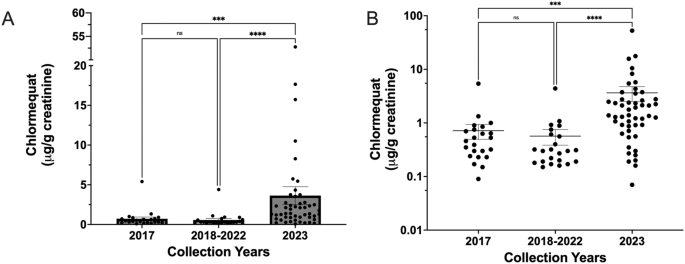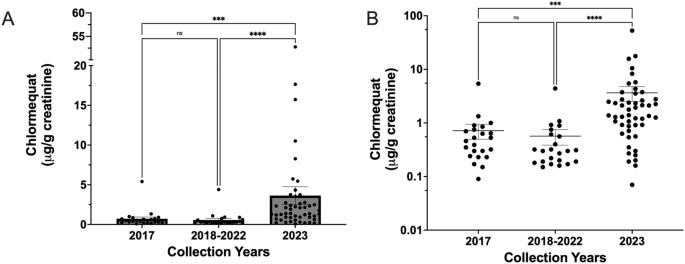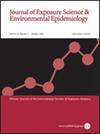一项关于 2017 年至 2023 年美国成人食物和尿液中灭草快含量的试点研究。
IF 4.1
3区 医学
Q2 ENVIRONMENTAL SCIENCES
Journal of Exposure Science and Environmental Epidemiology
Pub Date : 2024-02-15
DOI:10.1038/s41370-024-00643-4
引用次数: 0
摘要
矮壮素是一种植物生长调节剂,在北美谷物作物中的使用呈上升趋势。毒理学研究表明,暴露于百草枯的剂量低于监管机构设定的每日允许摄入量时,会降低生育能力并对发育中的胎儿造成伤害。在此,我们报告了在美国采集的尿液样本中发现的百草枯,在2017年、2018-2022年和2023年采集的样本中,检测频率分别为69%、74%和90%。在 2017 年至 2022 年的样本中,百草枯的检测浓度较低,而在 2023 年的样本中,百草枯的检测浓度显著增加。我们还观察到,燕麦类食品中的百草枯检测频率较高。这些发现和矮壮素毒性数据引起了人们对当前摄入量的关注,因此有必要开展更广泛的毒性测试、食品监测和流行病学研究,以评估人体摄入矮壮素对健康的影响。影响:这项研究首次报告了在美国人口和美国食品供应中检测到具有发育和生殖毒性的农用化学品百草枯。虽然在 2017 年至 2022 年的尿液样本中发现的该化学物质含量相似,但在 2023 年的样本中发现的含量明显增加。这项工作突出表明,有必要对美国食品和人体标本中的百草枯进行更广泛的监测,并对百草枯进行毒理学和流行病学研究,因为这种化学物质是一种新兴污染物,在动物研究中有低剂量不良健康影响的记录证据。本文章由计算机程序翻译,如有差异,请以英文原文为准。


A pilot study of chlormequat in food and urine from adults in the United States from 2017 to 2023
Chlormequat chloride is a plant growth regulator whose use on grain crops is on the rise in North America. Toxicological studies suggest that exposure to chlormequat can reduce fertility and harm the developing fetus at doses lower than those used by regulatory agencies to set allowable daily intake levels. Here we report, the presence of chlormequat in urine samples collected from people in the U.S., with detection frequencies of 69%, 74%, and 90% for samples collected in 2017, 2018–2022, and 2023, respectively. Chlormequat was detected at low concentrations in samples from 2017 through 2022, with a significant increase in concentrations for samples from 2023. We also observed high detection frequencies of chlormequat in oat-based foods. These findings and chlormequat toxicity data raise concerns about current exposure levels, and warrant more expansive toxicity testing, food monitoring, and epidemiological studies to assess health effects of chlormequat exposures in humans.
求助全文
通过发布文献求助,成功后即可免费获取论文全文。
去求助
来源期刊
CiteScore
8.90
自引率
6.70%
发文量
93
审稿时长
3 months
期刊介绍:
Journal of Exposure Science and Environmental Epidemiology (JESEE) aims to be the premier and authoritative source of information on advances in exposure science for professionals in a wide range of environmental and public health disciplines.
JESEE publishes original peer-reviewed research presenting significant advances in exposure science and exposure analysis, including development and application of the latest technologies for measuring exposures, and innovative computational approaches for translating novel data streams to characterize and predict exposures. The types of papers published in the research section of JESEE are original research articles, translation studies, and correspondence. Reported results should further understanding of the relationship between environmental exposure and human health, describe evaluated novel exposure science tools, or demonstrate potential of exposure science to enable decisions and actions that promote and protect human health.

 求助内容:
求助内容: 应助结果提醒方式:
应助结果提醒方式:


